Class 6 Science Chapter 2 Question Answers - Nutrition in Animals
| Table of contents |

|
| What is Animal nutrition? |

|
| Different Ways of Food Ingestion |

|
| Digestion |

|
| Digestion in Humans |

|
| Digestion in Grass Eating Animals (Ruminants) |

|
What is Animal nutrition?
Animal nutrition is the study of what animals eat and how their bodies use food to stay healthy, grow, and have energy. It includes understanding the different types of nutrients (like proteins, fats, and vitamins) that animals need to live and thrive.
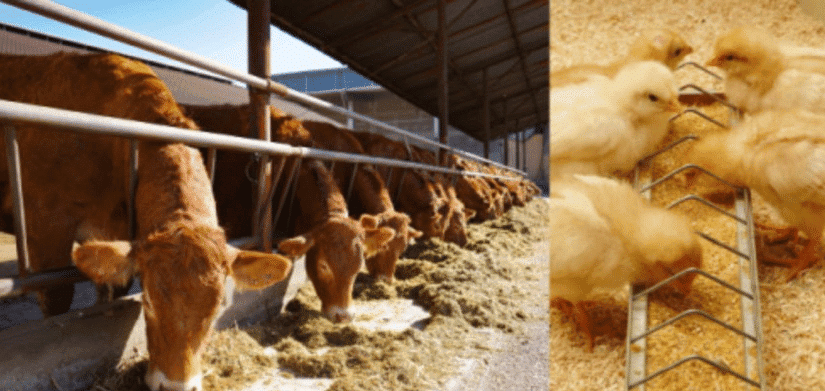 Animal Nutrition
Animal Nutrition
- Plants make their food by the process of photosynthesis, but animals cannot make their food themselves.
- Animals get their food from plants.
- Some animals eat plants directly while some animals eat plant-eating animals.
- Thus, animals get their food from plants either directly or indirectly.
Steps of nutrition in animals
- All organisms require food for survival and growth.
- The requirement of nutrients, mode of intake of food and its utilization in the body are collectively known as nutrition.
- Nutrition in complex animals involves the following steps:-
 Steps of Nutrition in Complex Animals
Steps of Nutrition in Complex Animals
- Ingestion- The intake of food is called ingestion. Method of ingestion, i.e. the taking of food, varies from one animal to another.
- Digestion - The process of breaking down of complex component of food into simpler substances is called digestion. The process of digestion is different in human, grass-eating animals, amoeba, etc.
- Absorption - The process of passing of digested food into blood vessels in the intestine is called absorption.
- Assimilation - The conversion of absorbed food in complex substances such as proteins and vitamins required by body is called assimilation. In other words, assimilation is the conversion of absorbed food (nutrients) into living tissues. Through the process of assimilation our cells are supplied with oxygen and nutrients.
- Egestion - The removal of waste materials from the body is called egestion. The faecal matter is removed through the anus from time to time. Since the waste of food left after digestion is also called faeces, hence the process of egestion is also known as defecation.
Different Ways of Food Ingestion
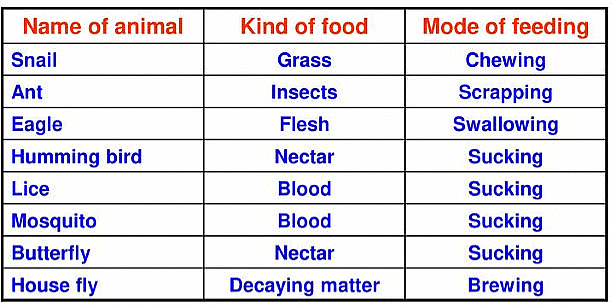 Examples of food ingestion
Examples of food ingestion
- A humming bird sucks nectar of plants.
- Human beings use their hands to put food into their mouth and swallow the food after chewing.
- Infants of human and many other animals feed upon their mother’s milk by sucking them.
- A snake swallows the animals they prey upon without chewing them.
- A frog captures prey with its sticky tongue.
- An earthworm uses its muscular pharynx to swallow its food.
- Spiders weave sticky web in which small insects get stuck.
- Some aquatic animals filter tiny particles floating nearby and feed upon them.
- Amoeba, a unicellular animal, engulfs tiny particles of food by using pseudopodia. Amoeba surrounds the food by pseudopodia and then makes a food vacuole to engulf the food.
- In multicellular organisms; like hydra there are numerous tentacles around their mouth. Hydra uses tentacles to surround its prey and kill them with its stinging cells. Then the food is pushed inside the body cavity.
Digestion
After taking of food, food is digested and then it is passed to the different parts of the body for the growth, repair and other vital functioning of the body.
- The food we take is primarily in the form of complex substances.
- Food in such complex form is not used as such by animals.
- Hence, they need to be first broken down into simpler soluble forms so that they can be absorbed by the cells of the body.
The process of breaking down complex component of food into simpler substances is called digestion.
- The process of digestion is different in human, grass-eating animals, amoeba, hydra, etc.
- Enzymes help in the breakdown of complex molecules like carbohydrates, protein, fats, etc. into simple molecules.
- Digestion in unicellular animals; like Amoeba; is intracellular. The digestive enzymes are secreted in the food vacuoles.
Questions:
Ques 1: What is ingestion?
Ans: The intake of food is called ingestion.
Ques 2: What is digestion?
Ans: The breaking down of solid and complex food into simple and soluble forms is called digestion.
Ques 3: What is absorption?
Ans: The process of passing of digested food into blood vessels in the intestine is called absorption.
Ques 4: What do you understand by assimilation?
Ans: The conversion of absorbed food in complex substances such as proteins and vitamins required by the body is called assimilation.
Ques 5: What do you understand by egestion?
Ans: Removal of waste materials from the body, time to time from the anus is called egestion.
Ques 6: What are the steps of nutrition involved in animals?
Ans: There are five steps of nutrition involved in animals. These are Ingestion, Digestion, Absorption, Assimilation and Egestion.
Ques 7: What are Pseudopodia?
Ans: The false feet of amoeba are called pseudopodia. (The word pseudopodia is the combination of pseudo and podus. Pseudo means false and podus means feet. Singular of pseudoposida is pseudopodium)
Digestion in Humans
- The digestive system of humans is well developed. It consists of the gut or alimentary canal, along with many associated digestive glands.
- The alimentary canal is divided into mouth, oesophagus, stomach, small intestine, large intestine and rectum.
 Digestive System and its Components
Digestive System and its Components
The Mouth and Buccal Cavity

- Human Mouth
- Mouth: The food is ingested through the mouth. The mouth contains tongue, teeth and salivary glands. Teeth break the food into smaller particles. This process is called mastication. The chewed food is mixed with saliva. Saliva is a watery fluid secreted by the salivary glands. Saliva contains a type of enzyme called the salivary amylase, which converts starch into sugar.
- Teeth: Our teeth cut, tear and grind the food before we swallow it. There are four types of teeth in our mouth.
- Incisors: These are flat and chisel-shaped teeth. They lie in the front of the mouth. There are eight incisor teeth; four in the upper jaw and four in the lower jaw. The incisor teeth are well adapted for cutting and biting of food items.
- Canines: These are round shaped, sharp and pointed teeth. Canines are well adapted to hold and tear the food. There are four canine teeth found in human.
- Premolars: There are two premolars on each side of each jaw. Premolars help in crushing and grinding the food. There are total 8 premolar teeth in an adult human.
- Molars: There are two molars on both sides in both the jaws. They have almost a flat surface with small projections. These teeth are meant for fine grinding of food. There are total 12 molar teeth including the wisdom teeth in an adult human. The 4 molar teeth are also called wisdom teeth. Wisdom teeth usually grow between the ages of 18 to 21. The tooth is covered with a white substance called enamel. It is the hardest substance in the human body.
Milk teeth and Permanent teeth
- Humans get two sets of teeth in their lifetime.
- The first set erupts when we are babies, are called milk teeth.
- Milk teeth last until we are about 8 years old.
- Milk teeth are replaced by the second set of teeth and are called permanent teeth.
- An adult human has 32 teeth in all; 16 in each jaw.
Tongue
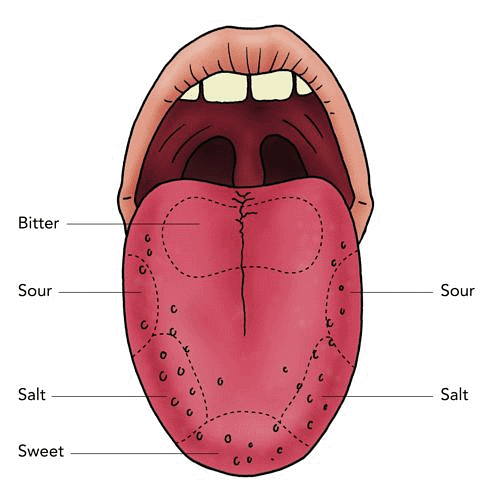 Human Tongue
Human Tongue
- The tongue is a muscular organ.
- Tongue helps to mix saliva in the food.
- It also helps to push the food down the food pipe or oesophagus.
- Taste receptors are present in tongue and give us the sense of taste.
Questions:
Ques 1: How many types of teeth are found in human beings?
Ans: There are four types of teeth in human beings. These are called incisors, canines, premolars and molars.
Ques 2: How many incisors are found in an adult human?
Ans: There are 8 incisors, 4 in lower and 4 in upper jaw, found in an adult human.
Ques 3: What is the function of incisors?
Ans: Incisors are used to cut and bite the food.
Ques 4: How many canines are found in an adult human?
Ans: There are four canine found in an adult human.
Ques 4: What is the functions of Canines?
Ans: Canines are the type of teeth, which help to hold and tear the food.
Ques 5: How many premolars are found in an adult human?
Ans: There are 8 premolars found in an adult human.
Ques 6: What is the function of premolars?
Ans: Premolars help in crushing and grinding the food.
Ques 7: How many molars are found in an adult human?
Ans: There are total 12 molars are found in an adult human.
Ques 8: What is wisdom tooth?
Ans: Wisdom teeth are molar teeth that grow usually between the age of 18 to 21 in an human.
Ques 9: How many teeth does a human adult have?
Ans: A human adult has 32 teeth in all; 16 teeth in each jaw.
Ques 10: What do you understand by milk and permanent teeth?
Ans: Human has two sets of teeth. These are called milk teeth and permanent teeth. Milk teeth start growing at the baby stage and are replaced gradually by permanent teeth from the age of 8 year.
Ques 11: What is Enamel?
Ans: The white substance that covers our teeth is called enamel. It is the hardest substances in the human body.
The Foodpipe/Oesophagus
- It is a tube-like structure connecting the mouth and the stomach. It is about 30 cm. long. Oesophagus has powerful muscles which gently push the food down to the stomach.
- The oseophagus contracts and relaxes in a rhythmic fashion to facilitate the forward movement of food. This movement happens in other parts of the alimentary canal as well and is called peristalsis.
- No digestion takes place in the oesophagus.
The Stomach
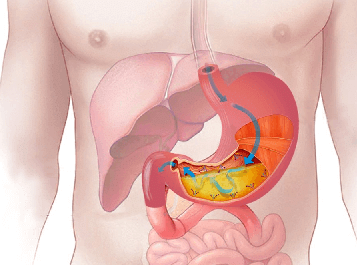 Digestive Juices get Mixed with Food
Digestive Juices get Mixed with Food
- It is a muscular J- shaped thick-walled bag.
- The stomach is the widest part of the alimentary canal.
- It receives food at one end from the food pipe and opens into the small intestine on the other end.
- Stomach churns the food to mix digestive juices. The food in the stomach is churned into semi-solid. The churned semi-solid food is called chime.
- Gastric juice is secreted from the wall of the stomach and mixed with food. Gastric juice contains some enzymes and hydrochloric acid. The enzymes present in the gastric juices break down protein from food.
- The hydrochloric acid kills the harmful bacteria present if any in the food and helps the gastric enzymes to work.
The Small Intestine
- The food leaves the stomach at certain intervals of time and enters into the small intestine.
- The small intestine is the longest part of the digestive system.
- It is about 20 feet or seven meters long in an adult human.
- Small intestine is a highly coiled tube.
- It consists of three parts: duodenum, jejunum and Ileum :
- In the duodenum, the liver and pancreas pour their secretions.
- Liver secretes bile juice and pancreas secretes the pancreatic juice.
- The bile juice contains the bile which carries out emulsification of fat. In this process, the fat is broken into tiny droplets.
- The pancreatic juice contains several enzymes. The enzymes of the pancreatic juice break down starch into simple sugars and proteins into amino acids.
- Minerals and vitamins do not need to be changed because cells are able to absorb them easily.
- From duodenum the food goes to the lower part of the intestine. There are numerous finger-like projections on the wall of the small intestine. These projections are called villi. They have fine blood capillaries to absorb the food.
- After absorption; food mixes in the blood stream and is carried to all the cells of the body.
The cells utilize this food to release energy.
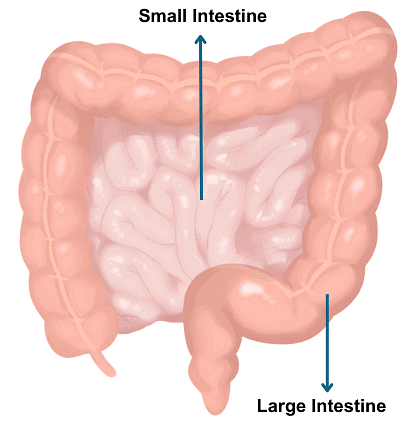 Intestines
Intestines
Large Intestine
- The digested food enters into large intestine after small intestine.
- The large intestine is wider and shorter than small intestine. It is about 1.5 metre in length.
- In large intestine excess of water from the materials is absorbed.
- The semi solid residue is stored in the last part of the large intestine called rectum and finally throw out of the body through the anus time to time.
- The throwing out of waste of digested food from rectum is called egestion.
- Egestion is also known as defecation.
Digestion in Grass Eating Animals (Ruminants)
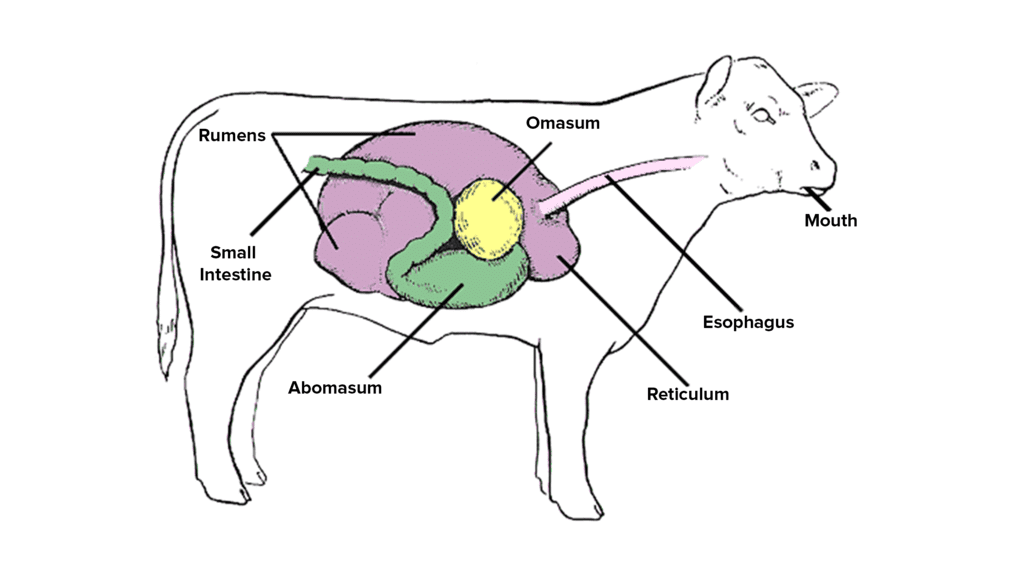 Digestion in Cow
Digestion in Cow
- The plant-eating animals digest their food in two steps. Their stomach is divided into four-chamber the rumen, reticulum, omasum and abomasum.
- First of all, half-chewed food is swallowed and it then goes from mouth to the rumen, the first chamber of the stomach. Here, it is acted upon by bacteria. These microorganisms digest cellulose.
- This half-digested food goes to the second muscular chamber; the reticulum. From the reticulum the food is sent back to the mouth; as cud; to be chewed again.
- Chewing of the cud is called rumination and such animals are called ruminating animals or ruminants. Cow, goat, buffaloes, sheep, bison, etc. are good examples of ruminating animals. The pre-chewed food is swallowed for the second time.
- After passing the first two chambers it enters the third chamber; the omasum. Here the food is further broken down into smaller pieces and finally enters the fourth chamber, the abomasum. Here, all enzymes act upon the food and the digestion is completed.
- After digestion and absorption, nutrients from food are taken to the cells in all parts of the body. The cells oxidize the food to release energy.
Questions:
Ques 1: What is a carnivorous animal? Give two examples.
Ans: Animals, which eat the flesh of other animals, are called carnivorous, e.g. lion, tiger.
Ques 2: What is the function of the digestive juice secreted by the liver?
Ans: The digestive juice from the liver breaks up fat into tiny particle.
Ques 3: Name the organs that make up the alimentary canal.
Ans: Mouth, oesophagus, stomach, small intestine, large intestine and rectum are the parts of the alimentary canal.
Ques 4: Name the four types of teeth.
Ans: The four types of teeth are: Incisors, Canines, Premolars and Molars.
Ques 5: Name the four compartments in a ruminant’s stomach.
Ans: Four compartments in a ruminant’s stomach: Rumen, reticulum, omasum and abomasums.
Choose the Correct Answer:
Ques 1: Movement of food through the alimentary canal is called by which of these terms?
(a) Locomotion
(b) Peristalsis
(c) Pumping
(d) Sliding.
Ans: (b) Peristalsis
Ques 2: The liver produces which of these enzymes?
(a) Amylase
(b) Trypsin
(c) Lipase
(d) None of these
Ans: (d) None of these.
Ques 3: Which of these is not a part of nutrition?
(a) Digestion
(b) Excretion
(c) Assimilation
(d) Egestion
Ans: (b) Excretion.
Ques 4: Digestive juice is not secreted by which of these organs?
(a) Small intestine
(b) Liver
(c) Stomach
(d) Oesophagus
Ans: (b) liver
Ques 5: The walls of the large intestine absorb which of these?
(a) Cellulose
(b) Digested food
(c) Oxygen
(d) Water
Ans: (d) Water.
Ques 6: Which of the following is not a part of ruminant stomach?
(a) Reticulum
(b) Anus
(c) Omasum
(d) Abomasum.
Ans: (b) Anus.
Ques 7: Bile is produced by which organ?
(a) Pancreas
(b) Gall bladder
(c) Liver
(d) Stomach.
Ans: (c ) Liver
Match the Following:
Ans: 1-E, 2-D, 3- B, 4- A, 5- C
Fill in the Blanks:
1- Most of the enzymes in the small intestine comes from ______
2-The __________ present on our tongue help us to taste food.
3-Saliva is secreted in the mouth by _______________
4-Living organism that cannot make their own food are called__________
Ans:
1- Stomach
2- Taste receptor
3- Salivary gland
4- Heterotrophic
Write True and False:
1- Absorption and assimilation are similar processes.
Ans: F
2- Some plants are heterotrophic and depend on others for food.
Ans: T
3- Hydrochloric acid is present in the stomach.
Ans: T
4- Pitcher plant is an example of insectivorous plant.
Ans: T
5- Saprophytes are green in colour.
Ans: F
6- Ruminants have a three-chambered stomach.
Ans: F
7- An adult human has 32 teeth in all – 16 in each row.
Ans: T
8- Tongue gives the sense of smell.
Ans: F
|
111 videos|286 docs|28 tests
|
FAQs on Class 6 Science Chapter 2 Question Answers - Nutrition in Animals
| 1. What is animal nutrition? |  |
| 2. What are the different ways animals ingest food? |  |
| 3. How does digestion differ between humans and ruminant animals? |  |
| 4. What are the key components of animal nutrition? |  |
| 5. How does animal nutrition play a role in animal health and performance? |  |
















